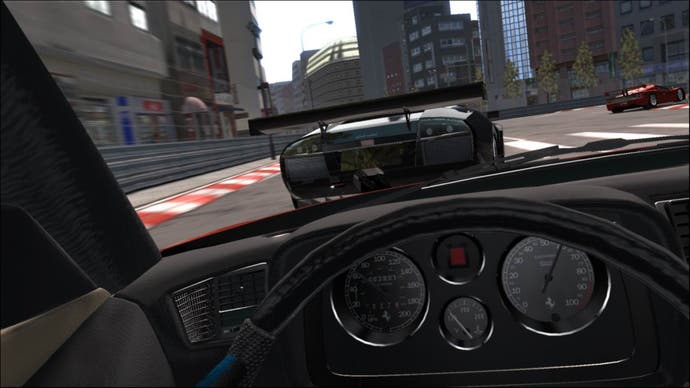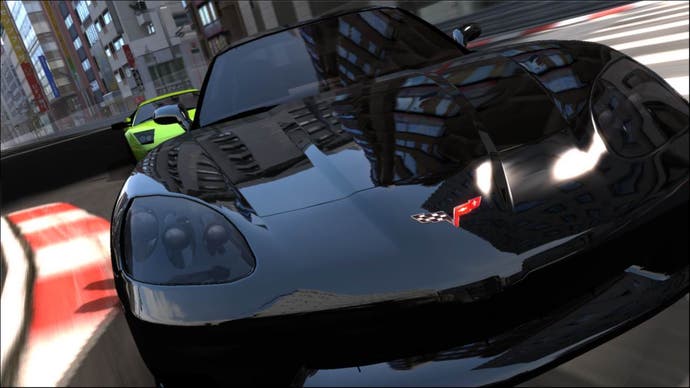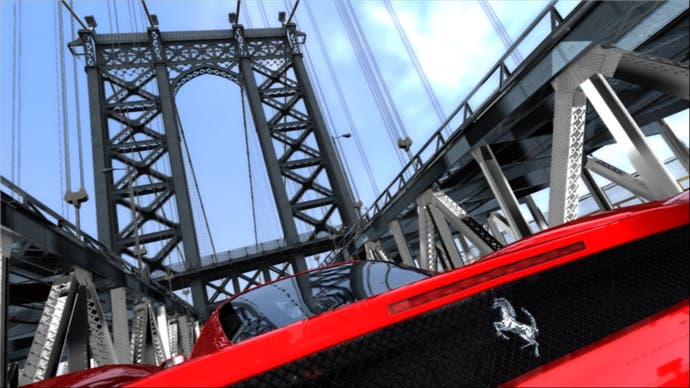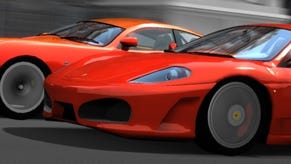Project Gotham Racing 3
Click. Click. Click-click-click. Aaah.
I used to live down a road that curved left, banana-like round to my house at the end. To get onto it you had to do a 90-degree right turn. What I used to do when I drove in was lock the steering hard right to enter, and then see how far I could get up the road as the steering wheel unravelled itself before the indicator registered the straightening and clicked off. Until it did that, it sounded like Kudos-clicking. That's about as close as I've ever come to PGR in real life.
(I'm going to die alone, aren't I?)
Anyway, PGR was always a brilliant idea. When it comes to that warning about not using these driving techniques in real-life that devs whack on the front of racing games these days, it lurks somewhere in the gap between Ridge Racer's "because you will die" allusions and GT's "because nobody's this good". When you clamp the accelerator and fishtail the back of the car and then wrestle it straight, it isn't just forgiving, it actually awards you points. Applying this to exiting tight turns and using a model that rewards sharp braking and traction loss was inspired.
It was inspired in Metropolis Street Racer, it was inspired in the first PGR. It's still inspired. It's not a realistic game - you bump and scrape when you should be deflating like a turbo-accordion, and the collisions between cars on the track and the AI drivers' apparent lack of concern about them and the way you're all bashing past each other is wrong, but that's easily overlooked because the core skill that it asks you to develop is so satisfying. And that clicking of the Kudos meter, which tots up points for drifting, drafting, riding the curb tightly, and comboing it all together and suchlike, tickles your ears with the promise of points to go with your podium positions.

PGR3 arrives on Xbox 360 with surprisingly little to add to the mechanics and structures that underpinned PGR2. Career mode allows you to pick one of five difficulty settings before tackling each challenge - and your daring or confidence in your ability informs the choice, because if you don't live up to the goal you've set you won't bank any points. Challenges range from racing and time trial affairs that are about speed to more technical cone and drift challenges that are about stringing Kudos-heavy moves together, and each adopts a different route through one of the game's city areas - London, Vegas, Tokyo, New York and Nurburgring (Ok so Nurburgring's not a city, but it might as well be for the distance and range it offers). On top of that, every single task synchs ever so elegantly with global leaderboards, so even the highest-ranked will have something more to push for.
Its principle divergence is in the way it separates these tasks from car classes. Now you simply go to a shop and buy yourself a car with credits earned by completing challenges - the idea being that you can use your favourite car throughout if you like. Along with the five grades of difficulty, this gives the game a level of accessibility that would've been alien in MSR or PGR, and even PGR2. You can make easier progress and move off tougher tasks by brushing them aside on lower difficulties, and the balance is such that even an accomplished racer will need to work for those Hard (gold) medals, which lurk tantalisingly just out of reach when you first attempt them, and their credit benefits, and Hardcore achievements are just that. Collecting cars as you go rather than having them prescribed will please everybody who ever whinged about the truck class in PGR2.
But you know what? I hate those bastards who whinged about the truck class, given what's happened. The concessions have bred profligacy by design. You gain enough credits by smashing through the relatively easy silver-medal band of races that you can amass a garage of Enzos, DBR9s, TVRs and other high-end machinery within a few short hours. The central Kudos mechanic of having to put your own imagined potential where your BHP is by selecting a target score before a race remains good - although personally I preferred the way you played with your shades of ambition by more closely defining your goals in the older games, half-second by half-second - but this is now more of a personal quest than a predefined one. It lacks incentives beyond the colours of medals, the ranks on Live and the badges you can earn that celebrate 360 spins and tasks completed in one combo. These are good incentives admittedly, but they're not as good as cars and new tracks were in the olden days.

PGR3 also plays with the separation of offline and online, and does this to better effect. Live's integration in single-player is limited to leaderboards and downloadable ghosts in Career mode (two of the best things ever done with Live, frankly), but now there's a distinct Online Career, with its own Live-specific Kudos-accumulation. There's a range of events to join in with at any given time. You can also set up your own Live races of course, in the game's Playtime area, and the way the game matches your connection speed and skill level to random opponents seems to work even at this early stage in the console's life.
The Route Creator, meanwhile, opens up a great many possibilities. It's simple to set up routes between start/finish and the waypoints available, and the results are easily distributable. But while the selection of cities is decent and the number of possibilities is barely conceivable (until a load screen somewhat comically suggests you "create over 100 million"), and nobody's questioning the devs' meticulousness in modelling each environment, the area covered is actually surprisingly small. Take London for example (since I live here) - the area covered is a fairly small section about ten minutes from my front door (by foot, mind you - not in a DBR9 or anything), and runs from Victoria Embankment through Trafalgar Square, loops round Piccadilly Circus without reaching upper Regent Street, and then circles back down to Pall Mall, St James's Park, and straight back to Big Ben. It's not that big. The Getaway's mapped area was many times the size and you could do the in-between bits. What is included works well - each city section features several memorable turns, straights and distinctive sections that combine to good effect, and to be fair Vegas and the winding sections of Tokyo feel more varied than London - but you have to wonder whether all that time wireframing buildings might have been better spent.
Which leads us inexorably to the question of how the game looks. This is undoubtedly the main thing people know about PGR3 at this point: the cars are enormously detailed, the environments are thoroughly mapped and modelled, and the visuals are presented in resolutions hitherto unseen on console hardware. And yeah, you've picked up on the tone - this is the point in the review where I say I don't think it makes as big a difference to the play experience as everyone's been so breathlessly declaring elsewhere.

Someone asked me a whole bunch of questions about PGR3's graphics yesterday. If it was true that the tarmac was virtually photo-realistic, if it was true all the pedestrians were 3d models, if it was true that you could stop and read the hoardings on the buildings, and see the light bouncing off windows and so on. Frankly I don't really know. My recollection of the tarmac is that it passes under me like a blurry grey conveyor belt, because I'm moving so damn fast. The spectators I only see when I stop, and that's only when I've screwed up, and when that's the case they're hardly my priority. The things you notice are the big things - the sun creeping over the skyscrapers in Shinjuku, the incredibly pronounced and sometimes blinding effect when you emerge from tunnels, the trees lining a road, the wealth of scenery. In terms of providing a world around the track, PGR3 goes the furthest so far, and yes, everything's presented in ways that other consoles can't present it, in a game that even PC owners who can reach these visual heights haven't much to compare directly to.
But you're only really going to notice where most of the grunt went in replays. Or on Gotham TV. The latter is a nice idea, but kind of ignores the unspoken truth about replay modes: they are boring. Watching the best of the best do their stuff is interesting, but watching eight mediocre players bashing into each other is not. Being one of as many as 30,000 people doing so simultaneously is a technical accomplishment, not an extra point on the score. Then if you look around, you're forced to admit that the spectators are automatons, and the trees aren't moving. It's quite a sterile environment, for all its definition and the wealth of objects outside the track boundaries.
But let's say you view it as a spectacular whole - even at this, for the most part the enormous amounts of incidental detail presuppose that you aren't actually racing. When you are, the key things are being able to see the next corner, or the next cone gate distinctly, and here the game is no better than any other. You'll notice far more impressive effects and depth of background material than you ever have before, and when you fiddle with that Photo viewer mode and actually marvel at the vehicle exteriors, you'll be hard pressed to think of another car model that includes as much. It's like watching those GT videos before Polyphony actually had to run them through the ancient PS2 graphics tech.

Hop into the cockpit view, which many are eulogising, and you'll certainly feel more immersed than you have elsewhere, owing thanks to the terrific engine sounds and enormous amount of in-car detail. But it's also kind of peculiar, because when you're in a car you don't find that half of your view is taken up by steering wheel, dashboard and the frame of the car; you focus on what's outside of the windscreen. The windscreen filter here is lovely, but unless you really divorce yourself from the interior modelling it feels more like you're leaning forward from the backseat, and the viewing window is quite restrictive. In the end I preferred the bumper cam, as I often do, not least because it's much easier to get a handle on the precise demands of the Kudos challenges and see what's coming when the track ahead fills the whole screen.
Let's give it its dues: when played from this perspective, PGR3 is an excellent, well-refined racing game. Cone Challenges, Drift Challenges, Street Races, Hot Laps, Eliminators, Time vs Kudos (where you stop the ticking down of the clock by playing up to the Kudos system - an excellent idea) - all are good, most are ridiculously compulsive thanks to the superb balancing of the medal targets, so much so that you'll happily pause and restart them every time you spin off and the chap ahead quickly builds up an unassailable lead. And while the range of challenges will probably feel a bit narrow to people who have stuck with the series since its birth on the Dreamcast, the temptation to try and scale those greater heights will appeal to the arcade mentality that still lurks within a lot of players.
But, as I keep saying, too much of what's changed since PGR2 is superficial once the initial novelty value of the graphics, Gotham TV, etc. wears off. PGR3's is a slightly flawed but overwhelmingly engaging framework for an already excellent skew on the driving models we're traditionally used to, and there's little else I'm going to turn to on Xbox Live for a significant time to come. But when I answered my friend's questions yesterday I simply said that it's like playing PGR2 on a system that can do it justice - and that comes close to summing it up. I will always love the thought of turning into my drive listening to the clicker, and PGR3 is still that feeling in game form - unfortunately, I'm starting to feel like I got home a long time ago.



